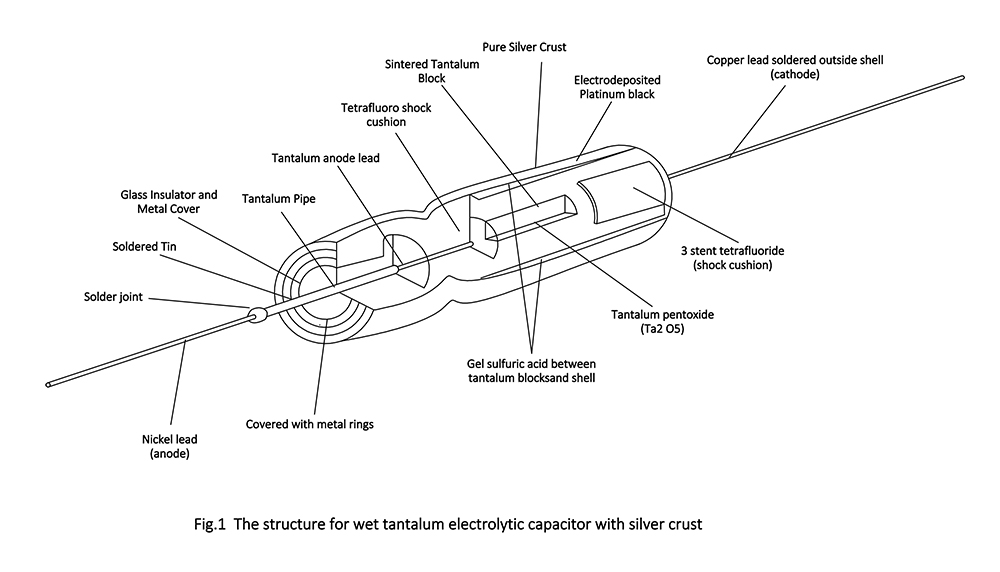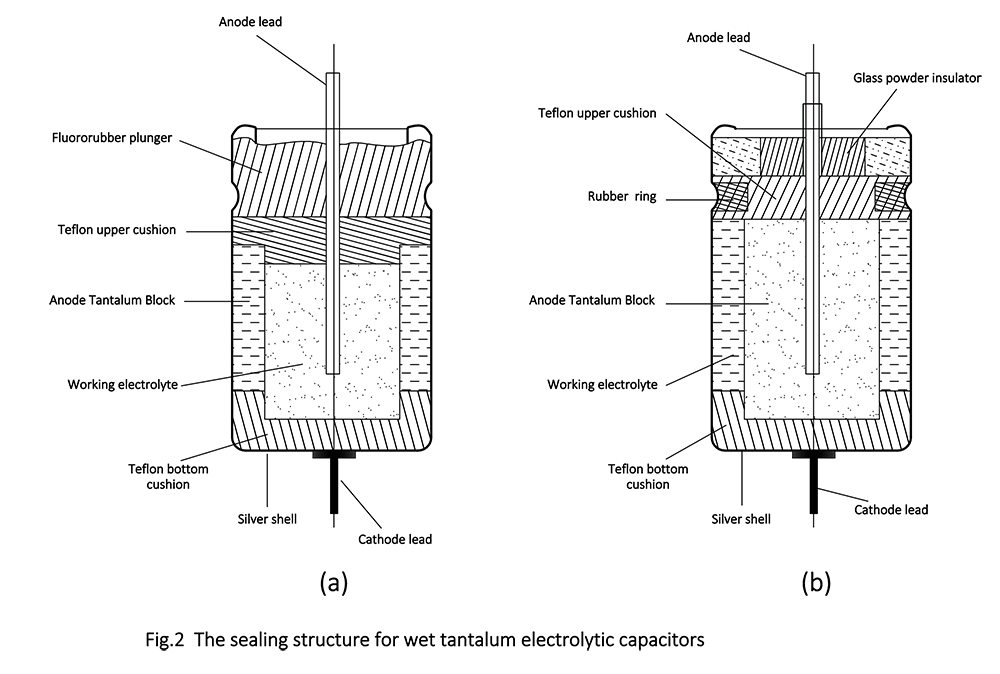All-tantalum Wet Electrolytic Capacitor With All-sealing Structure
All-tantalum wet electrolytic capacitors with all sealing structure can overcome many shortcomings existed in common wet electrolytic capacitor with silver crust, such as electrolyte leakage, instantaneous open circuit, electrical parameter worsening, silver ionic migration and so on. Hence, all-tantalum wet electrolytic capacitors with all-sealing structure have high reliability, steady performance and strong resistance to ripple electric current, and are reputed for “never disabled capacitor”
The electrochemical performance of wet electrolytic tantalum capacitor is good. Among all electrolytic capacitors, wet tantalum capacitors have the smallest leakage current and maximum CU product per unit (product of capacitance and rated voltage) which is more than 5 times bigger than other capacitors. Therefore, it is widely used in computer, radar, missile, supersonic aircraft, automatic control devices and other electronic circuits. However, wet tantalum electrolytic capacitors also fail due to leakage, instantaneous open circuit, deterioration of electrical parameters and silver ion migration.
With the improvement of function and speed of electronic circuit, a higher demanding for wet tantalum capacitor is put forward. In order to meet the needs of military and aerospace fields, all-tantalum wet electrolytic capacitor with all-sealing structure was developed. It not only maintains the advantages of wet tantalum electrolytic capacitor, but also serves its disadvantages. It has the advantages of stable performance, strong ability to withstand ripple current and high reliability, which is called as “never disabled capacitor”.
Structural And Performance Characteristics
1. Tantalum Extraction Cathode
The structure of all-tantalum wet electrolytic capacitor is basically the same as that of common silver shelled wet tantalum electrolytic capacitor (see Fig. 1). It is mainly composed of sintered tantalum core, Ta2O5 dielectric oxide film surface, electrolyte and metal shell. The difference is that all-tantalum wet electrolytic capacitor uses tantalum crust as the lead-out cathode, while ordinary wet tantalum electrolytic capacitor uses silver crust as cathode.
Currently, both CA30 and CAK35 series wet tantalum electrolytic capacitors use high purity silver crust as the lead cathode, which is the negative pole when capacitors are connected to circuit. But silver ion migration arises when reverse voltage or asymmetric ripple current added to the capacitor. When the reverse voltage is applied to the tantalum electrolytic capacitor or the ripple current is asymmetrical, the silver ions that the silver shell contacts gloriously under the action of acidic solution will gradually migrate and deposit on the surface of the anode medium which will form a conductive channel at the defect of the dielectric film. It will cause short circuit and sharp increase of leakage current and result in product loss effectiveness. To solve this problem, the United States developed all-tantalum wet electrolytic capacitors in 1976. Some manufacturers in China have also developed such products. All-tantalum wet electrolytic capacitors can avoid silver ion migration, decrease leakage current and improved reliability.
2. Special Technology of Tantalum Cathode To Enlarge Effective Surface
The key to manufacture large capacity tantalum electrolytic capacitors is to increase the effective surface of the cathode. The wet tantalum electrolytic capacitor with silver crust’s cathode is get by contacting the silver shell with the electrolyte. In the manufacturing process of wet tantalum electrolytic capacitors, there are double layer structures on the electrolyte solution and cathode surface. Therefore, the cathode capacitance exists on the lead-out cathode. Increasing the cathode capacitance can increase the total capacitance of the capacitor. In general, chemical or electrochemical corrosion is used to deposit a layer of precious metals such as platinum black and palladium black on the inner wall of the silver shell, so as to increase the effective surface of the cathode and achieve the purpose of increasing the cathode capacitance. Palladium is the best platinum group element for film forming, because it can produce the maximum capacitance to provide high efficient and large capacity capacitors.
For all-tantlaum wet electrolytic capacitors with all sealing structure, the cathode is made of tantalum, and tantalum is oxidized easily in air. Therefore, it is not feasible to increase the effective surface area of tantalum cathode by the method of treating silver cathode. Tantalum cathode surface treatment process is usually as follows: first, a small amount of hydrofluoric acid solution (or divalent tin salt, organic reductant) is used to treat the surface of Tantalum cathode, remove the oxide formed on the surface of the cathode, improve its surface adhesion, so as to form a solid platinum group metal film on its surface, and then chemical deposition method or sputtering side is used. The first discontinuous platinum group metal film with island structure was deposited on the surface of the Ta cathode which had removed the oxide film. Thereafter, in inert gas or vacuum environment, the first deposited metal film was heat treated to form an alloy between platinum group metals and tantalum metals to prevent the oxidation of tantalum metals in air. Finally, the second porous platinum group metal film is deposited on the first layer of alloy film by electroplating or other methods, which may not be the same metal as the first layer. Of course, platinum group metal films can also be directly formed on tantalum metal surface by sputtering, which can save the steps of removing tantalum oxide films with hydrofluoric acid, and then the surface of tantalum metal can be alloyed with platinum group metals by heat treatment. In addition, the oxide film on tantalum metal surface can be removed by glow discharge, and then platinum group metal film can be formed by sputtering. Because the tantalum metal surface and platinum group metals have been alloyed in the sputtering process, the heat treatment steps are omitted.
3. All Sealed Structure
Although wet tantalum electrolytic capacitors have the advantages of large capacity, their use has been limited due to leakage failure in the working process of semi-sealed structure. Leakage failure is a kind of failure phenomenon, which is caused by poor sealing of capacitors, when the gas pressure inside capacitors increases to a certain value under the conditions of thermal stress and electrical stress, and some working electrolytes leak out from the gap. Before the leakage problem was solved well, it was stipulated at some time in the past that electronic devices on satellites did not use wet tantalum electrolytic capacitors. This is because the acidic liquid in wet tantalum electrolytic capacitor can be conductive and corrosive. It will leak under high vacuum and weightlessness in the sky. Once it flows to the printed circuit board, the circuit will be short-circuited and the satellite will have serious faults, which will cause huge economic losses and adverse effects. The sealing structure of wet tantalum electrolytic capacitors can be divided into semi-sealed wet tantalum electrolytic capacitors (CA30) and fully sealed wet tantalum electrolytic capacitors (CAK39), as shown in Figs. 2 (a), (b).
Early wet tantalum electrolytic capacitors used semi-sealed structure, because of the structural defects, there may be electrolyte leakage, vaporization drying up and other problems. There are many reasons for leakage, for example, the expansion coefficients of silver shell and rubber plug are very different. When capacitors are in thermal expansion and cold contraction, rubber plug can not achieve ideal sealing effect. Many capillary grooves and stretches are formed on the surface of tantalum wire and the inner wall of silver shell during processing, which make the surface finish worse. The leakage channel of electrolyte is increased; moreover, the internal pressure of capacitor and the amount of electrolyte dripped into capacitor will affect the sealing performance. At present, the wet tantalum electrolytic capacitor adopts fully sealed structure, which solves the leakage problem. Leakage is rarely found in cold and hot dipping tests under high vacuum conditions. For fully sealed tantalum electrolytic capacitors, tantalum wires on the anode tantalum blocks are passed through the polytetrafluoroethylene gaskets with rubber rings, and then the tantalum cores are fixed with polytetrafluoroethylene gaskets and assembled into silver shells filled with gel electrolytes. Fixed the groove at the same height as rubber ring on the silver shell, and pierced glass powder insulator. Then rolled edge, edge welding between insulator and silver or tantalum shell, tantalum tube on insulator and high temperature argon arc ball welding and anode lead welding through tantalum wire in turn. In this way, the leakage problem of semi-sealed structure is completely solved. Due to the serious heat release from side welding, electrolyte vaporization will occur, resulting in pressure difference inside and outside the shell after cooling. According to the actual production experience, the process of first side welding and then ball welding is generally adopted.
4. Strong Vibration And Shock Resistance
The reason of instantaneous open circuit failure of wet tantalum electrolytic capacitor is that the liquid in the capacitor shell can not fix the tantalum block, the tantalum wire at the other end is fixed by the insulator, and the tantalum block and the tantalum wire become a cantilever. Therefore, centrifugal force makes the electrolyte move in the capacitor shell when the tantalum block is short or the quantity of electrolyte is large. When insufficient, centrifugal force may cause tantalum block to be separated from working electrolyte instantaneously, resulting in capacitor opening. Therefore, the proper length of tantalum block, sufficient electrolyte to be used, or the use of gel working electrolyte can reduce the possibility of instantaneous open circuit. In order to prevent the vibration of tantalum block, an anti-vibration washer is designed to fix the tantalum block, which effectively overcomes the instantaneous opening. Fully sealed tantalum electrolytic capacitors are superior to semi-sealed wet tantalum electrolytic capacitors in sealing performance, shock and vibration resistance and long-term reliability.
5. Maintaining Electrical Parameter Performance
When wet tantalum electrolytic capacitors are used for a long time, the capacitance decreases sharply and the tangent value of loss angle increases significantly. This is a gradual failure, which is caused by the continuous consumption of working electrolyte in capacitors. When the sealing performance is not good, the water in the electrolyte diffuses outward through the sealed rubber pad under the storage condition, and electrochemical dissociation of the water occurs under the working condition, which can make the water gradually reduce, the electrolyte gradually thicken, the viscosity gradually increase, the equivalent series resistance of the electrolyte increases, and the contact performance with the anodic oxide film becoming bad and resulting in a decrease in capacitance and an increase in loss.
In addition, the performance of working electrolyte has an important influence on maintaining the electrical parameters of wet tantalum electrolytic capacitors. Working electrolyte is the actual cathode of tantalum electrolytic capacitor. It contacts fully with Ta2O5 dielectric oxide film on the surface of anode base and inner wall of silver or tantalum shell. It can draw capacitance in the working process of capacitor, and it can repair the defective anodic oxide film in the process of aging and using of capacitor. The dielectric oxide film formed by the forming process is an insulating material with high electric field resistance, but it is not perfect. There are various very small defects and holes on its surface, so the capacitor must be repaired by sophisticated dielectric film. In the process of aging, the current density at the defect is high and the leakage current is high at the beginning. However, under the action of electrochemistry, the working electrolyte reacts with tantalum metal to form Ta2O5, which repairs the defect and makes the dielectric film more continuous and uniform. The leakage current decreases gradually with the extension of aging time. Similarly, when voltage is applied to both ends of the capacitor, the working electrolyte with strong oxidation ability will repair the damaged dielectric film at all times. It can be seen that the performance of working electrolyte will directly affect the reliability of tantalum electrolytic capacitor and its capacitance, loss, leakage current and electrical properties such as Res. In general, the working electrolyte of wet tantalum electrolytic capacitors should have the characteristics of high boiling point, low saturated vapor pressure, high conductivity and low Res. The wet tantalum electrolytic capacitors used at high voltage should also have high flashover voltage (which affects the rated working voltage of tantalum electrolytic capacitors). Therefore, the high performance electrolyte should be applied to electricity. It is of great significance to maintain and improve the reliability of performance parameters. At present, great progress has been made in the research of high performance electrolyte for tantalum electrolytic capacitors, and it has been applied in production.
More information: www.greentechee.com















